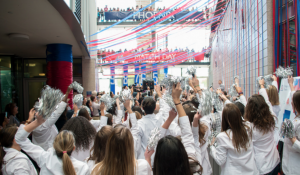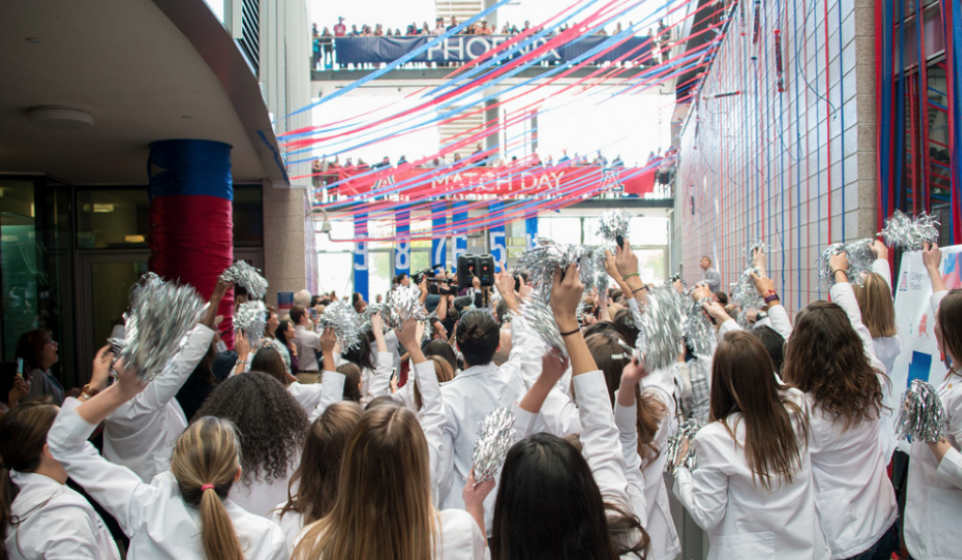
Photo Credit: University of Arizona College of Medicine – Phoenix Media Production
Banners were hung, confetti was strewn, students danced, and lots and lots of smiles were witnessed last month during what is arguably one of the most important and anticipated days of a medical student’s life . . . Match Day! The fateful day that marks the unofficial end of medical school and the start of the glorious career we’ve all worked so long towards . . . as finally an MD! Match Day celebration videos are plentiful all over the internet, depicting thrilled students ferociously ripping open letters and crying tears of joy as all of their dreams are realized and fears of uncertainty subside, emotions that are even more incredible to observe in person. But behind all the euphoria that is Match Day is, for some, the sudden angst that comes with the realization that their Match was unsuccessful.
Last year, 1093 medical students found themselves in this very predicament—having not gotten accepted at any residency program. So what’s a newly minted physician to do? Every year following Match Day, unmatched students are automatically entered into what is called the Supplemental Offer and Acceptance Program (SOAP), a one-week process that allows these students to then apply to any unmatched residency positions. Although this process has proven to be very efficient in the past, some students again fail to get matched through SOAP. These students either enter into a “transitional slot,” which mimics the fourth year of medical school, seek a research fellowship, or choose to teach science classes for a year until they attempt the Match again. Albeit frustrating, for many, these extracurricular opportunities help to differentiate the student and make them an even stronger candidate for the following year’s Match, increasing the likelihood of matching into a competitive specialty. But still some other rejected MDs note turning to waiting tables and applying to McDonald’s after not finding a placement through SOAP.
However, with the increasing demand for physicians, especially in rural areas, the question that is being is raised is whether clinics can scoop up these unmatched physicians and put them to work . . . Utilizing the skills they worked hard to obtain and also helping to ease the physician shortage burden. Missouri, Kansas, and Arkansas have all passed laws allowing unmatched graduates to work in medically underserved regions without first completing residency training by working under an “assistant physician” license. St. Louis plastic surgeon Dr. Edmond Cabbabe created the Missouri law after realizing how many physicians had “wasted all of their education” by not getting matched and thus not having a place to work in the healthcare delivery system. The law, which was passed in 2014, has not yet been implemented, but it will allow newly graduated doctors to work alongside an attending physician, who will supervise the new doctor for at least a month before allowing the new graduate to see patients on their own. Kansas, too, allows physicians who graduated from The University of Kansas School of Medicine to work as “graduate registered physicians” for up to two years, at which point they are then expected to move onto residency. While many supporters call these laws a solution to the physician shortage epidemic, many medical establishments frown on them. The AAMC’s senior director of government relations is concerned these physicians are treating patients without the critical skills they need that can only be taught through proper residency training. Instead, they recommend the government and insurance payers pitch in more money to create additional residency spots to accommodate more graduated physicians. Although the law was passed two years ago, no unmatched physicians have worked under these new licenses, and only time will tell if this becomes a blessing or a blunder.
- Bubenik, S. NOT A DOCTOR, JUST AN M.D. July 23, 2015. http://notadoctorjustamd.blogspot.com/2015/03/not-doctor-just-m.html
- For Med Students Who Didn’t Match, It’s a SOAP Opera. Medpage Today. March 20, 2015 http://www.medpagetoday.com/PublicHealthPolicy/MedicalEducation/50591
- Record-breaking Match sees higher percentage of unmatched seniors. AMA Wire. March 26, 2015. http://www.ama-assn.org/ama/ama-wire/post/record-breaking-match-sees-higher-percentage-of-unmatched-seniors
- Smith-Barrow, D. Options Exist for Med Students Without Residency Matches. US News & World Report. March 29, 2013. http://www.usnews.com/education/best-graduate-schools/top-medical-schools/articles/2013/03/29/options-exist-for-med-students-without-residency-matches
Rachel Antol is an MS2 at The University of Arizona College of Medicine – Phoenix. She graduated from Arizona State University in 2014 with a degree in biology and a concentration in developmental biology. Growing up with a passion for reading and writing, Rachel has been involved in various writing opportunities throughout her life and is very excited to bring this joy to her medical school. For any questions or interest in submitting an article, please contact her at rachelantol[at]email.arizona.edu.

